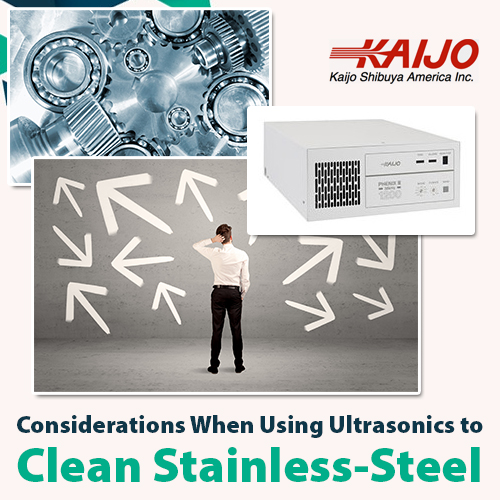Considerations When Using Ultrasonics to Clean Stainless Steel
February 8, 2022
 Because the lowest ultrasonic frequencies deliver powerful cleaning action, they can only be used for parts that have hard surfaces and that are not easily damaged. Parts made from stainless steel are usually robust and the stainless-steel surface is extremely hard. Low ultrasonic frequencies perform well with these parts, but cleaning performance is also influenced by the nature and characteristics of the contaminants.
Because the lowest ultrasonic frequencies deliver powerful cleaning action, they can only be used for parts that have hard surfaces and that are not easily damaged. Parts made from stainless steel are usually robust and the stainless-steel surface is extremely hard. Low ultrasonic frequencies perform well with these parts, but cleaning performance is also influenced by the nature and characteristics of the contaminants.
While ultrasonic cleaning systems used for stainless-steel parts are not sensitive to the frequency used, system characteristics such as a heated bath, the system power, and the addition of detergents or solvents to the bath can make the difference between adequate and superior cleaning performance. Both the time taken to clean the parts and whether all traces of the contaminants are removed can be affected. An experienced ultrasonic equipment manufacturer can help advise what type of system is needed and make sure the chosen ultrasonic cleaning system delivers the best performance possible.
How Ultrasonic System Characteristics Can Affect Cleaning Performance
Stainless steel parts can be cleaned with ultrasonic frequencies as low as 26 kHz to 40 kHz because the parts will not suffer mechanical damage or damage from surface pitting. At these frequencies, the system produces comparatively large cavitation bubbles with a strong scrubbing action to remove contaminants. When parts have caked-on deposits or heavy contamination with oil or grease, ensuring quick and complete cleaning can be challenging.
In addition to being strong and hard, stainless-steel is impervious to most solvents or detergents and is not sensitive to heat. Depending on the contaminants, stainless-steel parts can be cleaned more effectively by heating the cleaning solution or adding mild detergents to help dissolve the materials to be removed. If the parts are contaminated with several different substances, a combination of detergents and heat may be required.
For heavy contamination with hard deposits, solvents can often be found that will soften or dissolve the specific substance, thus speeding up removal by the action of ultrasonic cleaning bubbles. For oily or greasy deposits, mild detergents can break the adhesion that binds the contaminants to the stainless-steel surfaces, allowing them to be removed more easily by ultrasonic cleaning action.
Many organic contaminants form hardened deposits that can be difficult to remove. Heating the cleaning solution to below the boiling point will often soften the deposits and make them easier to remove. Since ultrasonic cleaning systems can be designed and configured with this capability, it is important to define the cleaning applications for which the system will be used before purchase. The type of contaminants to remove, the detergents or solvents needed to remove them, and the possible use of heating the tank impact the final decision on the ultrasonic cleaning system to use.
Kaijo Can Help with the Choice of the Best Ultrasonic Cleaning System
As one of the leading ultrasonic equipment manufacturers, Kaijo can make sure the chosen system meets expectations and performs as needed. With more than 70 years of experience working with ultrasonic technology, Kaijo is a world leader in the development of innovative easy to use ultrasonic cleaners. Kaijo designs and manufactures its own equipment, giving it the in-house expertise needed to advise customers. They provide ultrasonic cleaning systems that deliver excellent results and support customers with their cleaning applications.
Kaijo offers free consulting and can back up recommendations with equipment from their complete line of ultrasonic cleaning systems and components. Customers looking at specific cleaning requirements, such as stainless-steel parts, can depend on Kaijo to provide them with solutions to make sure the purchased equipment delivers optimal cleaning performance.





